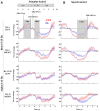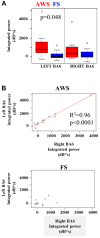Sensorimotor Oscillations Prior to Speech Onset Reflect Altered Motor Networks in Adults Who Stutter
- PMID: 27642279
- PMCID: PMC5009120
- DOI: 10.3389/fnhum.2016.00443
Sensorimotor Oscillations Prior to Speech Onset Reflect Altered Motor Networks in Adults Who Stutter
Abstract
Adults who stutter (AWS) have demonstrated atypical coordination of motor and sensory regions during speech production. Yet little is known of the speech-motor network in AWS in the brief time window preceding audible speech onset. The purpose of the current study was to characterize neural oscillations in the speech-motor network during preparation for and execution of overt speech production in AWS using magnetoencephalography (MEG). Twelve AWS and 12 age-matched controls were presented with 220 words, each word embedded in a carrier phrase. Controls were presented with the same word list as their matched AWS participant. Neural oscillatory activity was localized using minimum-variance beamforming during two time periods of interest: speech preparation (prior to speech onset) and speech execution (following speech onset). Compared to controls, AWS showed stronger beta (15-25 Hz) suppression in the speech preparation stage, followed by stronger beta synchronization in the bilateral mouth motor cortex. AWS also recruited the right mouth motor cortex significantly earlier in the speech preparation stage compared to controls. Exaggerated motor preparation is discussed in the context of reduced coordination in the speech-motor network of AWS. It is further proposed that exaggerated beta synchronization may reflect a more strongly inhibited motor system that requires a stronger beta suppression to disengage prior to speech initiation. These novel findings highlight critical differences in the speech-motor network of AWS that occur prior to speech onset and emphasize the need to investigate further the speech-motor assembly in the stuttering population.
Keywords: beta suppression; beta synchronization; developmental stuttering; magnetoencephalography; speech preparation.
Figures








Similar articles
-
A preliminary study on the neural oscillatory characteristics of motor preparation prior to dysfluent and fluent utterances in adults who stutter.J Fluency Disord. 2018 Mar;55:145-155. doi: 10.1016/j.jfludis.2017.05.003. Epub 2017 May 17. J Fluency Disord. 2018. PMID: 28577876
-
White matter microstructural differences underlying beta oscillations during speech in adults who stutter.Brain Lang. 2021 Apr;215:104921. doi: 10.1016/j.bandl.2021.104921. Epub 2021 Feb 4. Brain Lang. 2021. PMID: 33550120
-
When will a stuttering moment occur? The determining role of speech motor preparation.Neuropsychologia. 2016 Jun;86:93-102. doi: 10.1016/j.neuropsychologia.2016.04.018. Epub 2016 Apr 19. Neuropsychologia. 2016. PMID: 27106391
-
Stuttering severity relates to frontotemporal low-beta synchronization during pre-speech preparation.Clin Neurophysiol. 2022 Jun;138:84-96. doi: 10.1016/j.clinph.2022.03.010. Epub 2022 Mar 21. Clin Neurophysiol. 2022. PMID: 35366481
-
Cognitive behavior therapy for adults who stutter: a tutorial for speech-language pathologists.J Fluency Disord. 2009 Sep;34(3):187-200. doi: 10.1016/j.jfludis.2009.09.002. Epub 2009 Oct 4. J Fluency Disord. 2009. PMID: 19948272 Review.
Cited by
-
Increase in Beta-Band Activity during Preparation for Overt Speech in Patients with Parkinson's Disease.Front Hum Neurosci. 2017 Jul 24;11:371. doi: 10.3389/fnhum.2017.00371. eCollection 2017. Front Hum Neurosci. 2017. PMID: 28790903 Free PMC article.
-
Functional Roles of Sensorimotor Alpha and Beta Oscillations in Overt Speech Production.bioRxiv [Preprint]. 2024 Oct 8:2024.09.04.611312. doi: 10.1101/2024.09.04.611312. bioRxiv. 2024. PMID: 39416142 Free PMC article. Preprint.
-
Aberrant neurophysiological signaling associated with speech impairments in Parkinson's disease.NPJ Parkinsons Dis. 2023 Apr 14;9(1):61. doi: 10.1038/s41531-023-00495-z. NPJ Parkinsons Dis. 2023. PMID: 37059749 Free PMC article.
-
Cortical dynamics of disfluency in adults who stutter.Physiol Rep. 2017 May;5(9):e13194. doi: 10.14814/phy2.13194. Physiol Rep. 2017. PMID: 28483857 Free PMC article.
-
Functional and Neuroanatomical Bases of Developmental Stuttering: Current Insights.Neuroscientist. 2019 Dec;25(6):566-582. doi: 10.1177/1073858418803594. Epub 2018 Sep 28. Neuroscientist. 2019. PMID: 30264661 Free PMC article. Review.
References
LinkOut - more resources
Full Text Sources
Other Literature Sources

